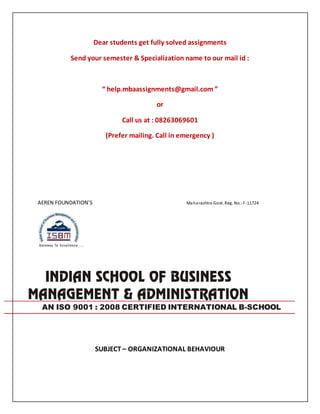
Organization behaviour
- 1. Dear students get fully solved assignments Send your semester & Specialization name to our mail id : “ help.mbaassignments@gmail.com ” or Call us at : 08263069601 (Prefer mailing. Call in emergency ) AEREN FOUNDATION’S Maharashtra Govt. Reg. No.: F-11724 AN ISO 9001 : 2008 CERTIFIED INTERNATIONAL B-SCHOOL SUBJECT – ORGANIZATIONAL BEHAVIOUR
- 2. Q.1. Define organizational behavior, and organizational structure? Answer: There are a variety of different models and philosophies of organizational behavior. Areas of research include improving job performance, increasing job satisfaction, promoting innovation and encouraging leadership. In order to achieve the desired results, managers may adopt different tactics, including reorganizing groups, modifying compensation structures and changing the way performance is evaluated. Organizational behavior is a study of the way people interact within groups. Normally this study is applied in an attempt to create more efficient business organizations. The central idea of the study of organizational behavior is that a scientific approach can be applied to the management of workers. Organizational behavior theories are used for Q.2. What is the difference between a manager and a leader? Do leaders need different skillsto be effective? Answer: Perhaps there was a time when the calling of the manager and that of the leader could be separated. A foreman in an industrial-era factory probably didn’t have to give much thought to what he was producing or to the people who were producing it. His or her job was to follow orders, organize the work, assign the right people to the necessary tasks, coordinate the results, and ensure the job got done as ordered. The focus was on efficiency. But in the new economy, where value comes Q.3. What is the difference between a group & a team? What are the different types of workteams? Answer: Many people used the words team and group interchangeably, but there are actually a number of differences between them in real world applications. A number of leadership courses designed for the corporate world stress the importance of team building, not group building, for instance. A team's strength depends on the commonality of purpose and interconnectivity between individual members, whereas a group's strength may come from sheer volume or willingness to carry out a single leader's commands.It is often much easier to form a group than a team. If you had a room filled with professional accountants, for example, they could be Q.4. How would you define conflict? Distinguish between functional & dysfunctional conflictsby giving suitable examples? Answer: We define conflict as a disagreement through which the parties involved perceive a threat to their needs, interests or concerns. Within this simple definition there are several important understandings that emerge:
- 3. Disagreement - Generally, we are aware there is some level of difference in the positions of the two (or more) parties involved in the conflict. But the true disagreement versus the perceived disagreement may be quite different from one another. In fact, Q.5. Explain the different types of employee involvement and employee recognitionprograms with the help of suitable examples. Answer: An Employee involvement program -helps with building morale, fostering a spirit of teamwork among management and employees and strengthening relationships with key stakeholders. Yet, there have been limited studies focusing on the needs of corporations in order to help them conduct more effective programs. Employee Picnic-An employee picnic is a celebration! It's a celebration of their hard work, reaching goals and most of all, togetherness. A picnic is a time-proven way to show your employees how much you care for them and their families! Holiday Party-reward your employees with some Q.6. Select the most appropriate answer of the following: (20, each 2 marks) 1) The groups to which an individual aspires to belong, i.e. the one with which he or sheidentifies is called a) coalitions b) committees c) reference groups d) task groups 2) One small drawback of the five-stage model is that it a) ignores the organizational context b) ignores the situational factors c) ignores the individual attributes d) ignores the formal structure
- 4. 3) Individual employees can be converted into team players through a) appropriate feedback b) training c) monitoring d) demonstration 4) One who tries to bring discipline and order through formal structures, plans andprocesses and tries to monitor performance against plans is a a) leader b) manager c) co-ordinator d) team-player 5) If the followers are able and unwilling, then the leader will have to use the a) authoritarian style b) participative style c) situational style d) strategic style 6) According to situational leadership approach, the style that denotes a high-task and alow-relationship style is a) selling style b) delegating style c) participating style d) telling style
- 5. 7) Decision-making heavily depends on the individual a) understanding b) creativity c) perception d) ability 8) In formal groups and organizations, an individual has maximum access to a) referent power b) reward power c) legitimate power d) coercive power 9) In an attempt to preserve their perceptions, people tend to a) resist change violently b) ignore the change process c) create bottlenecks for change agents d) process information selectively 10) The process, which is aimed at seeking change in attitudes, stereotypes andperceptions, that groups hold of each other is called a) Organizational development b) Inter-group development c) T-groups d) Team-building
- 6. Dear students get fully solved assignments Send your semester & Specialization name to our mail id : “ help.mbaassignments@gmail.com ” or Call us at : 08263069601 (Prefer mailing. Call in emergency )
